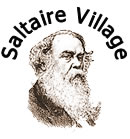 |
| The Saltaire Journal |
|
|
|
|
|
|
| Useful |
|
|
|
|
|
| |
|
| |
|
|
 | Home | Social History | The Saltaire Journal | Home | Social History | The Saltaire Journal |
|
|
|
|
| THE SALTAIRE JOURNALS - INDEX PAGE |
| THE SALTAIRE JOURNALS - FREELY AVAILABLE
The Saltaire Journals publish newly researched articles which relate to Saltaire and its history. Each Journal consists of a single topic by an author or group of authors.
The Journals are published as new research is written up, and are available to download on a world-wide basis to non-commercial parties such as local historians, and research and educational bodies, from this website. Any copyrights attached to an article are made known in its issuing. A limited number of copies are printed centrally, for deposition in libraries, archives and other outlets.
Production of the Saltaire Journals is by an informal group of enthusiasts. Publication is by Nemine Juvante (Saltaire) Publications, a not-for profit partnership dedicated to the publishing of works relating to the UNESCO World Heritage Site of Saltaire. The facility is free to contributors and readers alike. The Saltaire Journals are Acrobat files. They vary in length, but may take some time to download. |
|
ABOUT THE SALTAIRE JOURNAL
Backgound information: how to contribute, availability of issues and the Belwarp logo. More >
OUR MISSION
To document the history of the UNESCO World Heritage Site of Saltaire, by providing a means for historians to publish findings on that history, and on topics which relate to that history.
HOW TO CONTRIBUTE
House style and advice on the inclusion of images.
More >
CONTACT
Email Dave Shaw, Editor and Publisher of The Saltaire Journals.
saltairejournal@saltairevillage.info
|
| |
Volume 1, Number 1 Published 1 November 2007
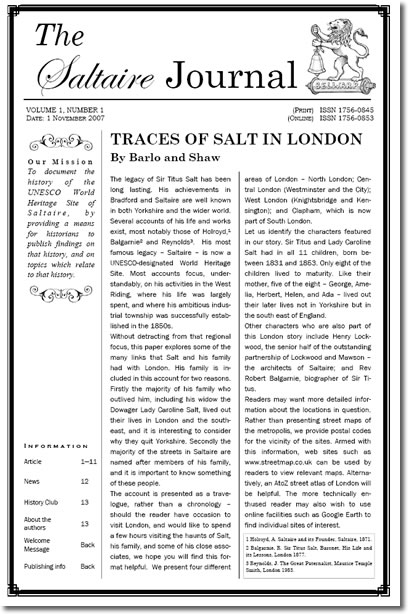 Traces of Salt in London Traces of Salt in London
By Barlo and Shaw
Read this Saltaire Journal >
(Acrobat file: Size 3.1 MB)
The legacy of Sir Titus Salt has been long lasting. His achievements in Bradford and Saltaire are well known in both Yorkshire and the wider world. Several accounts of his life and works exist, most notably those of Holroyd, Balgarnie and Reynolds. His most famous legacy – Saltaire – is now a UNESCO-designated World Heritage Site. Most accounts focus, understandably, on his activities in the West Riding, where his life was largely spent, and where his ambitious industrial township was successfully established in the 1850s. Without detracting from that regional focus, this paper explores some of the many links that Salt and his family had with London.
|
| |
| Volume 1, Number 2 Published March 2009
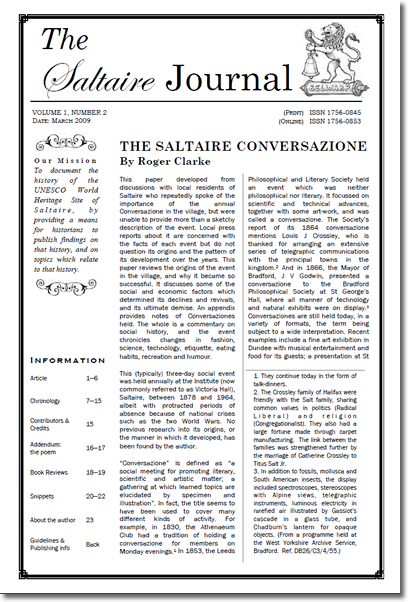 The Saltaire Conversazione The Saltaire Conversazione
By Roger Clarke
Read this Saltaire Journal >
(Acrobat file: Size 2.8 MB)
This paper developed from discussions with local residents of Saltaire who repeatedly spoke of the importance of the annual Conversazione in the village, but were unable to provide more than a sketchy description of the event. Local press reports about it are concerned with the facts of each event but do not question its origins and the pattern of
its development over the years. This
paper reviews the origins of the event
in the village, and why it became so
successful. It discusses some of the
social and economic factors which
determined its declines and revivals,
and its ultimate demise. An appendix
provides notes of Conversaziones
held. The whole is a commentary on
social history, and the event
chronicles changes in fashion,
science, technology, etiquette, eating
habits, recreation and humour. |
| |
| Volume 1, Number 3 Published July 2009
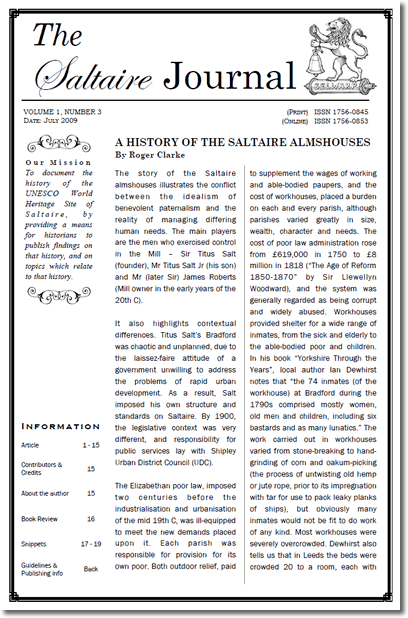 The History of the Saltaire Almshouses The History of the Saltaire Almshouses
By Roger Clarke
Read this Saltaire Journal >
(Acrobat file: Size 6.9 MB)
The story of the Saltaire
almshouses illustrates the conflict
between the idealism of
benevolent paternalism and the
reality of managing differing
human needs. The main players
are the men who exercised control
in the Mill – Sir Titus Salt
(founder), Mr Titus Salt Jr (his son)
and Mr (later Sir) James Roberts
(Mill owner in the early years of the
20th C).
It also highlights contextual
differences. Titus Salt’s Bradford
was chaotic and unplanned, due to
the laissez-faire attitude of a
government unwilling to address
the problems of rapid urban
development. As a result, Salt
imposed his own structure and
standards on Saltaire. By 1900,
the legislative context was very
different, and responsibility for
public services lay with Shipley
Urban District Council (UDC). |
| |
| Volume 1, Number 4 Published March 2010
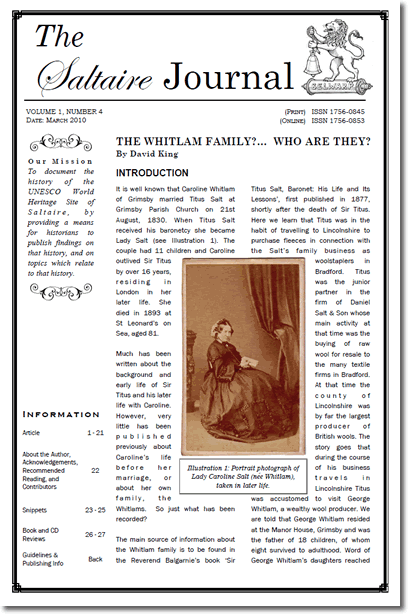 The Whitlams?... Who Are They? The Whitlams?... Who Are They?
By David King
Read this Saltaire Journal >
(Acrobat file: Size 16.7 MB)
It is well known that Caroline Whitlam
of Grimsby married Titus Salt at
Grimsby Parish Church on 21st
August, 1830. When Titus Salt
received his baronetcy she became
Lady Salt (see Illustration 1). The
couple had 11 children and Caroline
outlived Sir Titus
by over 16 years, residing in
London in her
later life. She
died in 1893 at
St Leonard’s on
Sea, aged 81.
Much has been
written about the
background and
early life of Sir
Titus and his later
life with Caroline.
However, very
little has been
published
previously about
Caroline’s life
before her
marriage, or
about her own
family , the
Whitlams. So just what has been recorded? |
| |
| Volume 1, Number 5 Published March 2010
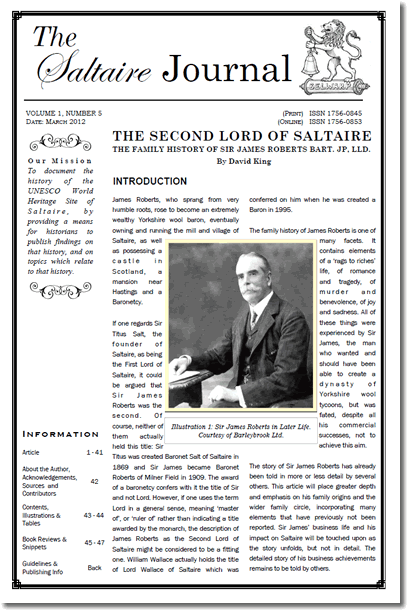 The Second Lord of Saltaire The Second Lord of Saltaire
The family history of Sir James Roberts BART. JP. LLD.
By David King
Read this Saltaire Journal >
(Acrobat file: Size 68.2 MB)
James Roberts, who sprang from very
humble roots, rose to become an extremely
wealthy Yorkshire wool baron, eventually
owning and running the mill and village of
Saltaire, as well
as possessing a
castle in
Scotland, a
mansion near
Hastings and a Baronetcy.
If one regards Sir
Titus Salt, the
founder of
Saltaire, as being
the First Lord of
Saltaire, it could
be argued that
Sir James
Roberts was the second. Of course, neither of them actually held this title: Sir Titus was created Baronet Salt of Saltaire in 1869 and Sir James became Baronet Roberts of Milner Field in 1909. The award of a baronetcy confers with it the title of Sir and not Lord. However, if one uses the term
Lord in a general sense, meaning ‘master
of’, or ‘ruler of’ rather than indicating a title
awarded by the monarch, the description of
James Roberts as the Second Lord of
Saltaire might be considered to be a fitting
one. |
| |
|
|
|
|


 Traces of Salt in London
Traces of Salt in London The Saltaire Conversazione
The Saltaire Conversazione  The History of the Saltaire Almshouses
The History of the Saltaire Almshouses  The Whitlams?... Who Are They?
The Whitlams?... Who Are They?  The Second Lord of Saltaire
The Second Lord of Saltaire